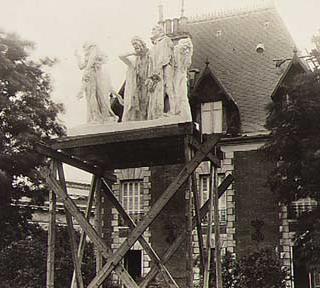H. de Roos - Rodin´s Approach to Art |
|
14. The pedestal: the right point of view After The Burghers of Calais had been inaugurated at the entrance of the Jardin du Front Sud, on a pedestal designed by the city architect Decroix, with an octagonal iron gate around it, Rodin resented this installation and returned to his previous proposal as worded in his letter of 8 December 1893 to Dewavrin, his Burghers could be mounted on a very low, “but impressive” basis on the Place d´Armes in the centre of Calais. In his later conversations with Gsell, he even complained the “ugly and superfluous” pedestal of Decroix had been forced on him, although he would have preferred the six Burghers to be anchored into the pavement directly – this way it would look as if the six men would walk between the inhabitants of the city. In fact, his grudge was mainly caused by the refusal of the Calais City Council to position his Monument either in front of the Town Hall or along the Route Nationale in the neighbourhood of the Pont Richelieu – an alternative location the sculptor had suggested. He felt the location in front of the public gardens was too much offside, as if the City was ashamed to present its brave citizens in their state of humiliation and despair – a suspicion he shared with Sir Schomberg McDonnel, Secretary of the London Office of Works, who had come to view the group in Calais and mocked Rodin´s work had been installed before the background of a public urinal and a washing room. |
|
As Thomas Appels demonstrates, it would be wrong to conclude, though, that Rodin would reject the idea of a pedestal altogether – his main concern was to reach an installation that would allow for the highest aesthetic effect. Whereas a low placement would bring the suffering of the Burghers closer to the spectator and invite to direct identification, a higher position would produce a good contrast between the lively contours and the sky. Accordingly, the Copenhagen cast of the Burgers was put on a 1.40 meter high base, the London version in the Victoria Towers Garden even became a five meter high pedestal, like the Gattamelata statue by Donatello in Padua. Before, Rodin had raised a wooden platform on his Meudon property, to test the effect of such a high position. His revolutionary idea of a very low placement was only realised in Calais in 1924, after the sculptor had died and the exceptional quality of his disquieting - but meanwhile widely celebrated - monument was better understood. |
Jacques-Ernest Bulloz |
The Gates of Hell was never cast in bronze during Rodin´s lifetime. It was only by commission of the American collector Jules Mastbaum that a bronze copy was made in 1929; the second cast went to the Musée Rodin. The Monument to Balzac was first cast in bronze in 1939, to be placed at the Boulevard Raspail, and the 1897 plaster model of the Victor Hugo Monument made its way to the foundry only in 1964, to be placed at the intersection of the avenues Victor Hugo and Henri-Martin.
|
|
|
|
|
|
Notice:
Museum logos appear only as buttons linking to Museum Websites and do not
imply any |
|
